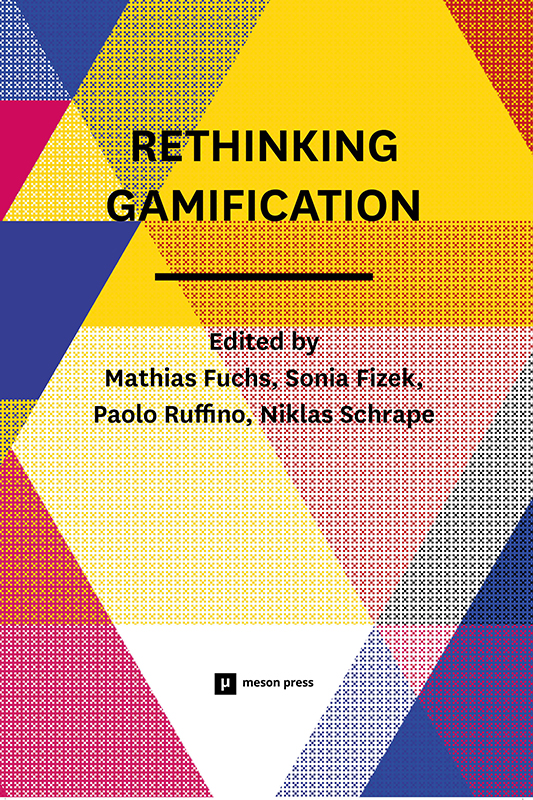Rethinking Gamification by Fuchs Mathias / Fizek Sonia / Ruffino Paolo

Author:Fuchs, Mathias / Fizek, Sonia / Ruffino, Paolo [Paolo, Fuchs, Mathias / Fizek, Sonia / Ruffino,]
Language: eng
Format: epub
Tags: Gamification, Game Studies, Media Studies
Publisher: meson press by Hybrid Publishing Lab
Published: 2014-12-10T16:00:00+00:00
1.1 Functionaries and Freedom
The investigation of human communication methods requires an understanding of cultural historicity, taking into account the various communicational codes currently stacked in layers. Flusser’s analysis (2000, 2011a) begins with oral codes, with traditional images – such as petroglyphs – and with texts until it reaches, finally, images produced by apparatuses, produced by a new communicational code, which succeeds texts and inaugurates, as described above, post-history: an age where the process of codification is transferred to outside the body, into the interior of the technical or social apparatus.
The transfer of the codifying capacity to a foreign agent creates a bond of connection between technology and human beings that, according to Flusser (2000), is shown in the figure of the apparatus-functionary complex, which forms a union that cannot be considered separately.
The concept of apparatus-functionary is essential to understand the current cultural situation, since it has reconfigured the relationship between mankind and technology. Flusser defines the functionary as being someone who plays with the apparatus but does not understand how its programming is done and thus cannot have any kind of critical insight into its processes. What remains to the functionary is only to act according to the apparatus.
Historically, the relationship between man and technology occurs in two distinct ways: sometimes technology works for man, sometimes man works for technology (ibid.).
Before the Industrial Revolution, the transformation of nature into culture was executed mainly via technical instruments called tools. In the Renaissance period, at any shoemaker’s workshop the production’s value resided in the hands of the artisan. The shoemaker’s tools were simply variables in his work, working for him. With the industrial revolution and its mechanisation of production, this relation is inverted and man becomes the variable, that is to say, an external agent in a system regulated by machines.
In our first example, the tool is an instrument for freedom while in the second the machine is a mechanism for imprisonment. The novelty of our current situation is the apparent equilibrium between man and technology, when both are merged in unison.
The apparatus is not an instrument, let alone a machine, but rather its synthesis. The machines’ trapping annuls the freedom characteristic of the instrument, which in the apparatus is manifested as a phenomenon of thirdness through which both apparatus and functionary are mutually conditioned.
In the case of video games, this mutual conditioning stems from the actualisation of potentialities contained within the programming codes and through the process of interaction between the player and the technical discourse contained in the apparatus.
Murray’s definition (1997, 126) regarding agency as “the satisfying po-wer to take meaningful action and see the results of our decisions and choices” is intimately related to the freedom described above. Freedom, in the case of video games, is contained in the symbiosis between apparatus and player-functionary. The player is free to take action to reach desired results as long as these actions are codified in the interior of the apparatus.
The matter of the fact is, in order not to frustrate the
Download
This site does not store any files on its server. We only index and link to content provided by other sites. Please contact the content providers to delete copyright contents if any and email us, we'll remove relevant links or contents immediately.
Deep Learning with Python by François Chollet(12956)
A Developer's Guide to Building Resilient Cloud Applications with Azure by Hamida Rebai Trabelsi(10375)
Hello! Python by Anthony Briggs(10198)
The Mikado Method by Ola Ellnestam Daniel Brolund(10106)
OCA Java SE 8 Programmer I Certification Guide by Mala Gupta(10043)
Dependency Injection in .NET by Mark Seemann(9580)
Hit Refresh by Satya Nadella(9016)
Algorithms of the Intelligent Web by Haralambos Marmanis;Dmitry Babenko(8587)
The Kubernetes Operator Framework Book by Michael Dame(8372)
Exploring Deepfakes by Bryan Lyon and Matt Tora(8175)
Robo-Advisor with Python by Aki Ranin(8128)
Practical Computer Architecture with Python and ARM by Alan Clements(8112)
Implementing Enterprise Observability for Success by Manisha Agrawal and Karun Krishnannair(8090)
Building Low Latency Applications with C++ by Sourav Ghosh(7981)
Svelte with Test-Driven Development by Daniel Irvine(7980)
Sass and Compass in Action by Wynn Netherland Nathan Weizenbaum Chris Eppstein Brandon Mathis(7969)
Grails in Action by Glen Smith Peter Ledbrook(7941)
Becoming a Dynamics 365 Finance and Supply Chain Solution Architect by Brent Dawson(7902)
Test-Driven iOS Development with Swift 4 by Dominik Hauser(7900)
